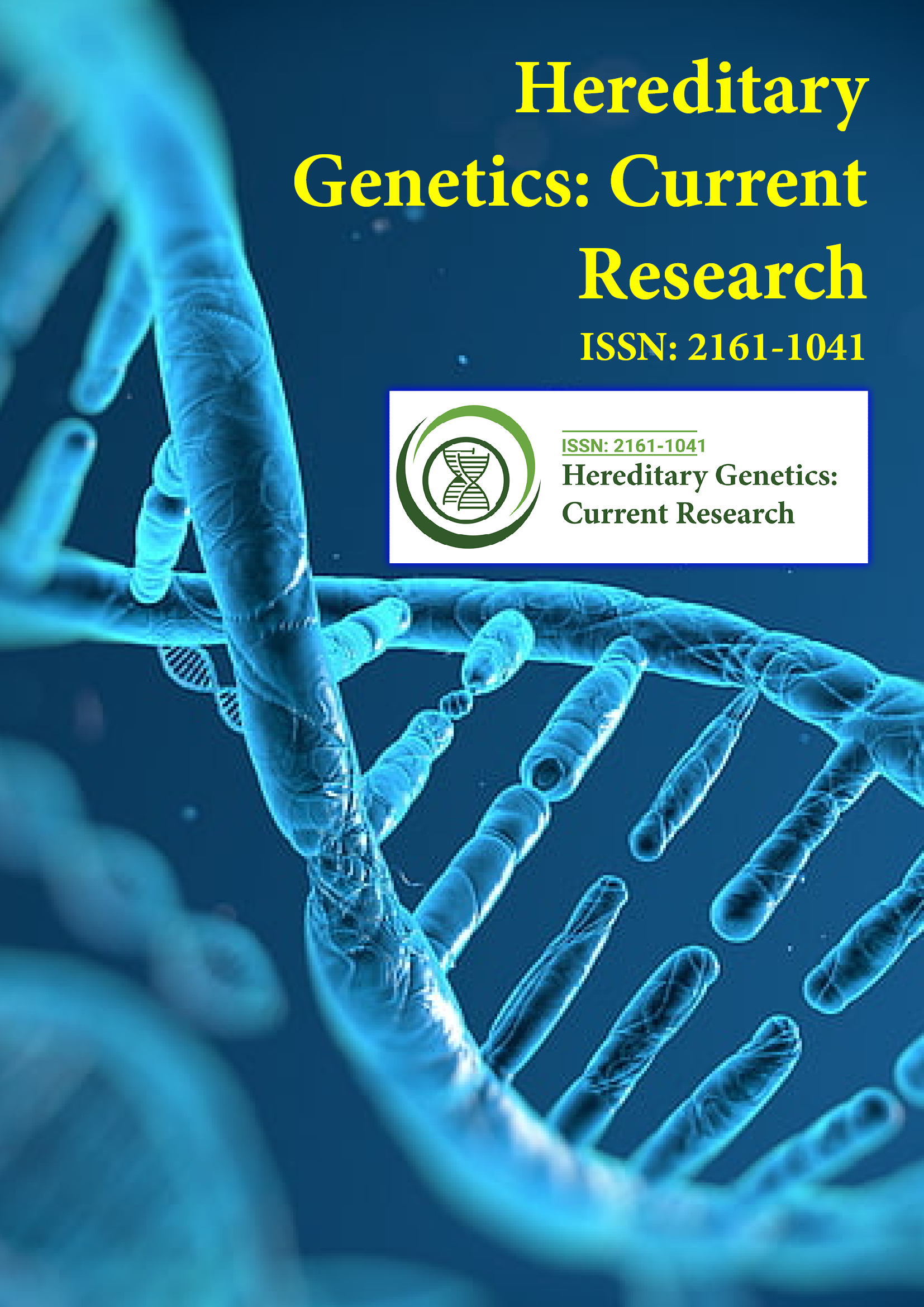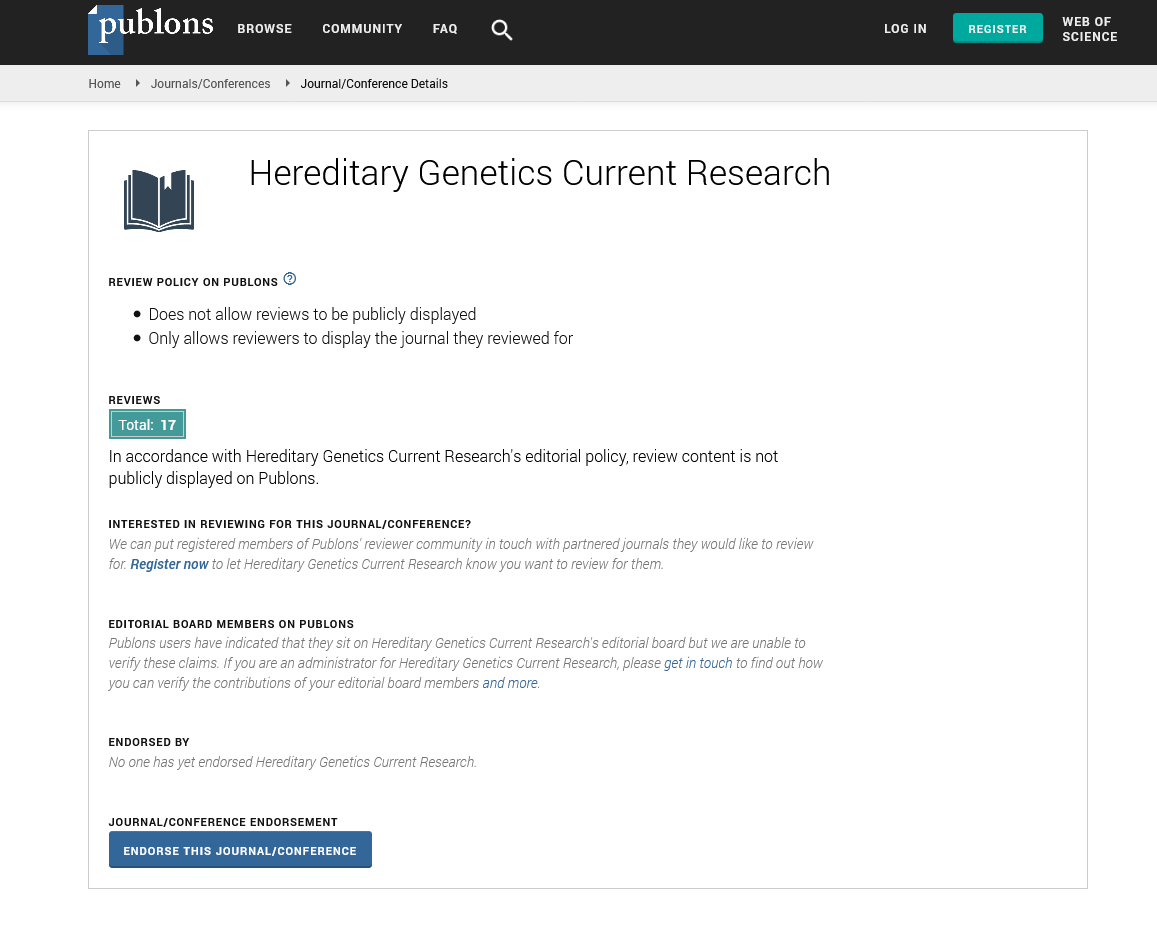Indexed In
- Open J Gate
- Genamics JournalSeek
- CiteFactor
- RefSeek
- Hamdard University
- EBSCO A-Z
- NSD - Norwegian Centre for Research Data
- OCLC- WorldCat
- Publons
- Geneva Foundation for Medical Education and Research
- Euro Pub
- Google Scholar
Useful Links
Share This Page
Journal Flyer

Open Access Journals
- Agri and Aquaculture
- Biochemistry
- Bioinformatics & Systems Biology
- Business & Management
- Chemistry
- Clinical Sciences
- Engineering
- Food & Nutrition
- General Science
- Genetics & Molecular Biology
- Immunology & Microbiology
- Medical Sciences
- Neuroscience & Psychology
- Nursing & Health Care
- Pharmaceutical Sciences
Short Communication - (2022) Volume 11, Issue 2
Significance and Clinical Disorders of Chromosomal Abnormalities.
Nagwa Meguid*Received: 01-Mar-2022, Manuscript No. HGCR -22-16433; Editor assigned: 04-Mar-2022, Pre QC No. HGCR -22-16433 (PQ); Reviewed: 18-Mar-2022, QC No. HGCR -22-16433; Revised: 25-Mar-2022, Manuscript No. HGCR -22-16433; Published: 04-Apr-2022, DOI: 10.35248/ 2161-1041.22.11.210
Description
Chromosomal abnormalities are clearly defined as the absence of extra parts of chromosomal DNA. Chromosomal abnormalities can be divided into two groups: numerical and structural abnormalities. An example of a numerical abnormality is Down's syndrome. Chromosomal abnormalities occur when there is an error in cell division. There are two types of cell division, mitosis and meiosis. Examples of chromosomal abnormalities include Wolf-Hirschhorn syndrome, Jacobsen syndrome, Angelman syndrome, Turner syndrome, Trisomy X syndrome, and Williams’s syndrome.
Chromosomal abnormalities lead to mental retardation and other physical abnormalities. This is a genetic abnormality that causes a child to have a variety of facial features, including: Round face and Mongolian tilt or upward tilt of eye sockets. Most human chromosomal abnormalities occur in autosomal chromosomes. Most of these abnormalities are chromosomal and trisomy. Due to its monosomy, there is only one replication of each type of chromosome, not the standard pair of homologous chromosomes. Trisomy has three chromosomes of each type. All embryos with an autosomal chromosome are suddenly truncated from the beginning of pregnancy. In addition, virtually all embryos with trisomy are inherited before birth [1]. Those who survive usually have other real mutations, intellectual disabilities, and a reasonably short lifespan. The incidence of severe chromosomal abnormalities is 50% of conceptions ending in spontaneous abortion, and 50% of those miscarriages have severe chromosomal abnormalities.
Chromosomal abnormalities account for 7% of serious birth defects. Turner syndrome is the most common. Genetic mutations account for an additional 8% of cases. Ploidy is an extra set of chromosomes. Aneuploidy is an extra or missing chromosome. One chromosome is another. Trisomy is another chromosome. Deletions are the missing parts of the chromosome. Duplications are chromosomes that are present twice in this area. In a translocation, two chromosomes join the arm or swap parts. Inversion is the inversion of a part of the chromosome. Isochromosomes are chromosomes with the same arm. Ring chromosomes are chromosomes that form rings due to telomere deletions and cause locks to stick together [2].
Chromosomal abnormalities usually occur when there is an error in cell division. During mitosis and meiosis, cell division errors can result in cells with too little or too many chromosome replications. Mitosis results in two cells that are copies of the first cell. The cells with 46 chromosomes are separated into two cells with 46 chromosomes each. This type of cell division occurs systemically except for regenerative organs. This is how most of the cells that make up our body are made and replaced. Meiosis produces the majority of chromosomes, 23 cells instead of the usual 46. Errors can also occur if the chromosome is replicated [3].
Maternal age
Some analysts acknowledge that as we get older, oocyte genetic material errors can appear. Older women are at higher risk of giving birth to babies with chromosomal abnormalities than younger women. Father's age does not pose a risk of chromosomal abnormalities, as men produce new sperm throughout their lives.
Chromosomal abnormalities
Chromosomal abnormalities result from adjustments in the number or design of chromosomes. Each of our chromosomes has a characteristic structure. In the past, researchers have used staining strategies to stain chromosomes in striped designs. These banding patterns make it easy to identify each chromosome, as on a map. The bundle of chromosomes found under the magnifying glass is called the karyotype [4]. Deviations from the normal karyotype are called chromosomal abnormalities.
Numerical abnormalities
The most serious chromosomal problems are caused by unhappiness or acquisition of the entire chromosome. This can affect hundreds or even thousands of genes and is generally fatal.
Due to the small size of the chromosomes, the inclusion of several genes, or the unique elements that help regulate gene mass, there are few numerical abnormalities that support the progress made so far.
Structural abnormalities
Structural chromosomal abnormalities occur when the structure or part of a chromosome is adjusted. The total number of chromosomes is usually 46, which is the absolute number of each cell. Structural chromosomal abnormalities occur when one part of a chromosome is lost, one part of the chromosome is no longer needed, or a section exchanges spots with another. These are generally divided into "short arms" and "long arms" of chromosomes. The short arm at the top of the chromosome is called the "p-arm". The long arm "q arm" is at the base of the chromosome. The centromere is the central part of the chromosome that appears to be "sandwiched" between the p-arm and the q-arm. Multifunctional disorders are more common than monogenic and chromosomal abnormalities. They arise from the association of many genes with natural elements [5]. The ideal precautions rely on avoiding terrible natural variables, as resistance to acquiring bad genes is currently unrealistic.
REFERENCES
- Herrera S, Lora J, Hormaza JI, Herrero M, Rodrigo J. Optimizing production in the new generation of apricot cultivars: self-incompatibility, S-RNase allele identification, and incompatibility group assignment. Front Plant Sci. 2018;9:527.
[Crossref] [Google Scholar] [Pubmed]
- Pairon M, Petitpierre B, Campbell M, Guisan A, Broennimann O, Baret PV, et al. Multiple introductions boosted genetic diversity in the invasive range of black cherry (Prunus serotina; Rosaceae). Annals of Botany. 2010;105(6):881-890.
[Crossref] [Google Scholar] [Pubmed]
- Luikart G, Allendorf FW, Cornuet JM, Sherwin WB. Distortion of allele frequency distributions provides a test for recent population bottlenecks. J hered. 1998;89(3):238-247.
[Crossref] [Google Scholar] [Pubmed]
- Verma KS, Kachhwaha S, Kothari SL. RAPD and ISSR marker assessment of genetic diversity in Citrullus colocynthis (L.) Schrad: a unique source of germplasm highly adapted to drought and high-temperature stress. Biotech. 2017; 7(5):1-24.
[Crossref] [Google Scholar] [Pubmed]
- Tripathi N, Chouhan DS, Saini N, Tiwari S. Assessment of genetic variations among highly endangered medicinal plant Bacopa monnieri (L.) from Central India using RAPD and ISSR analysis. Biotech. 2012;2(4):327-336.
Citation: Meguid N (2022) Significance and Clinical Disorders of Chromosomal Abnormalities. Hereditary Genet. 11:210.
Copyright: © 2022 Meguid N. This is an open access article distributed under the terms of the Creative Commons Attribution License, which permits unrestricted use, distribution, and reproduction in any medium, provided the original author and source are credited.

